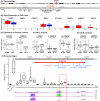GWAS meta-analysis and replication identifies three new susceptibility loci for ovarian cancer
- PMID: 23535730
- PMCID: PMC3693183
- DOI: 10.1038/ng.2564
GWAS meta-analysis and replication identifies three new susceptibility loci for ovarian cancer
Abstract
Genome-wide association studies (GWAS) have identified four susceptibility loci for epithelial ovarian cancer (EOC), with another two suggestive loci reaching near genome-wide significance. We pooled data from a GWAS conducted in North America with another GWAS from the UK. We selected the top 24,551 SNPs for inclusion on the iCOGS custom genotyping array. We performed follow-up genotyping in 18,174 individuals with EOC (cases) and 26,134 controls from 43 studies from the Ovarian Cancer Association Consortium. We validated the two loci at 3q25 and 17q21 that were previously found to have associations close to genome-wide significance and identified three loci newly associated with risk: two loci associated with all EOC subtypes at 8q21 (rs11782652, P = 5.5 × 10(-9)) and 10p12 (rs1243180, P = 1.8 × 10(-8)) and another locus specific to the serous subtype at 17q12 (rs757210, P = 8.1 × 10(-10)). An integrated molecular analysis of genes and regulatory regions at these loci provided evidence for functional mechanisms underlying susceptibility and implicated CHMP4C in the pathogenesis of ovarian cancer.
Figures




References
-
- Lichtenstein P, et al. Environmental and heritable factors in the causation of cancer-- analyses of cohorts of twins from Sweden, Denmark and Finland. N.Engl.J.Med. 2000;343:78–85. - PubMed
-
- Stratton JF, Pharoah PDP, Smith SK, Easton DF, Ponder BAJ. A systematic review and meta-analysis of family history and risk of ovarian cancer. British Journal of Obstetrics and Gynaecology. 1998;105:493–499. - PubMed
-
- Antoniou AC, Easton DF. Risk prediction models for familial breast cancer. Future Oncol. 2006;2:257–74. - PubMed
Publication types
MeSH terms
Grants and funding
- P30 CA016672/CA/NCI NIH HHS/United States
- R01 CA087538/CA/NCI NIH HHS/United States
- P30 CA072720/CA/NCI NIH HHS/United States
- R37 CA070867/CA/NCI NIH HHS/United States
- 11022/CRUK_/Cancer Research UK/United Kingdom
- P30 CA008748/CA/NCI NIH HHS/United States
- P30 CA076292/CA/NCI NIH HHS/United States
- R01 CA083918/CA/NCI NIH HHS/United States
- 15601/CRUK_/Cancer Research UK/United Kingdom
- R01 CA122443/CA/NCI NIH HHS/United States
- U19 CA148112/CA/NCI NIH HHS/United States
- WT_/Wellcome Trust/United Kingdom
- U19-CA148112/CA/NCI NIH HHS/United States
- 10118/CRUK_/Cancer Research UK/United Kingdom
- 15960/CRUK_/Cancer Research UK/United Kingdom
- R01 CA149429/CA/NCI NIH HHS/United States
- 13086/CRUK_/Cancer Research UK/United Kingdom
- R01 CA112523/CA/NCI NIH HHS/United States
- P50 CA136393/CA/NCI NIH HHS/United States
- 16561/CRUK_/Cancer Research UK/United Kingdom
- 10124/CRUK_/Cancer Research UK/United Kingdom
LinkOut - more resources
Full Text Sources
Other Literature Sources
Medical

